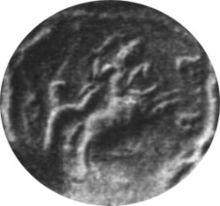Pavle Bakić
| Despot Pavle Bakić Pavle Bakić | |||||
|---|---|---|---|---|---|
| Serbian Despot | |||||
 Seal of Pavle Bakić (1533) | |||||
| Despot of Serbia | |||||
| Reign | 1537 | ||||
| Predecessor | Radič Božić | ||||
| Born | Šumadija, Ottoman Empire (today Serbia) | ||||
| Died | 20 September 1537 Đakovo, Habsburg Monarchy (today Croatia) | ||||
| Spouse | Teodora | ||||
| |||||
| House | Bakić | ||||
| Religion | Serbian Orthodox Christian, later Protestant[1][need quotation to verify] | ||||
Pavle Bakić (Template:Lang-sr, Template:Lang-hu; ca. 1525 - 20 September 1537) was the last Despot of Serbia, he ruled a large territory under the Hungarian crown until his death in 1537.
Background
This section is empty. You can help by adding to it. (September 2011) |
Life
Pavle had a Turkish timar, as did his father, and was the lord of great estates around Venčac in Šumadija called "Bakić's land". He was highly viewed of by the Ottoman Empire, and had the rights to collect taxes (kharaj) from his people.
In consultation with Pál Tomori and Louis II of Hungary, Pavle Bakić left his land with his family, five brothers, and a great number of Serbs, into Hungary, and in return he received the town of Lak among other estates. With his forces he participated in the Battle of Mohács in 1526.
After the battle the Šajkaši were still unpaid for their services. Ferdinand reprimanded the court for nothing having paid at least part of the unpaid salary to the Šajkaši.[2] Bakić once again turned to Ferdinand, alerting him that the nonpayment to the Šajkaši would cause estrangement of the Serbs in his lands, and those of John Zápolya and the Ottoman Empire.[2] He also informed Ferdinand of the persecution of Serbs by the Austrian staff and officers.[2]
When the succession war between Ferdinand I and John Zápolya started, he took the side of Zápolya. After the defeat of Zápolya in the Battle of Tokaj in 1527, Bakić sided with Ferdinand, and would stay faithful to him for the rest of his life. In 1528, Ferdinand confirmed Bakić and his brothers' holdings and appointed him the captain of the Serbian infantry, cavalry and river forces. In the Siege of Vienna in 1529, Bakić was an important aspect with his cavalry. After the Ottoman conquest of Syrmia, Radoslav Čelnik sough refuge in Bakić's lands, in Bur.[3] In charters of 1534, Ferdinand again confirmed Bakić and his brothers' holdings (Lak, Győr, Szombathely, Hédervár and all estates that were part of these towns). The fortress of Győr was administered by his Hungarian ally Count György Cseszneky. A charter dated September 20, 1537, titles him as Despot and called all Serbs to join Bakić as the Serbian Despot.
Attempts made by King Ferdinand to push the Ottomans out of Slavonia, with the use of Pavle, were not successful. In 1537, Bakić did not manage to liberate Osijek from the Ottomans, he then retreated towards Đakovo, where he died at the battle of Gorjani against the Ottomans. Mehmed-paša sent his son with the head of Bakić to Constantinople.
Family
He had two daughters:
- Margit, married Menyhért Balassa)
- Angelika, married Imre Révay, later Imre Czobor.
See also
References
- ^ http://www.szombathely-lutheran.hu/egyhaztortenet/egyhazkozseg-27.html
- ^ a b c Kolundžija 2008, p. 184.
- ^ Đuro Vukelić; Četnici Gacke doline; Saborci u slobodnom svetu (1991). Gacka dolina i okolina na predstraži srpstva i pravoslavlja. Četnici Gacke doline. p. 43.
Sources
- Kolundžija, Zoran (2008). Vojvodina: Od najstarijih vremena do velike seobe. Prometej.
{{cite book}}: Invalid|ref=harv(help) - Popović, Dušan J. (1990). Srbi u Vojvodini. Vol. 1. Matica srpska.
{{cite book}}: Invalid|ref=harv(help) - Samardžić, Radovan; Veselinović, Rajko L.; Popović, Toma (1993). Radovan Samardžić (ed.). Istorija srpskog naroda. Treća knjiga, prvi tom: Srbi pod tuđinskom vlašću 1537-1699. Belgrade: Srpska književna zadruga.
- Lemajić, Nenad, Donation charters of the Bakić family, in Istraživanja 2005, iss. 16, pp. 153–169,
- Stanojević, Pavle, Classification of archive material in the Church of Saints Peter and Paul in Arad a comprehensive list of documents, in Temišvarski zbornik 2006, iss. 4, pp. 143–174, Matica srpska, Novi Sad
- Božanić, S. 2007, "Srem in the period between 1502 and 1526", Spomenica Istorijskog arhiva Srem, no. 6, pp. 72–88.
- Aleksa Ivić: Istorija Srba u Vojvodini. Novi Sad 1929.
- Istanbul Britannica, Istanbul
